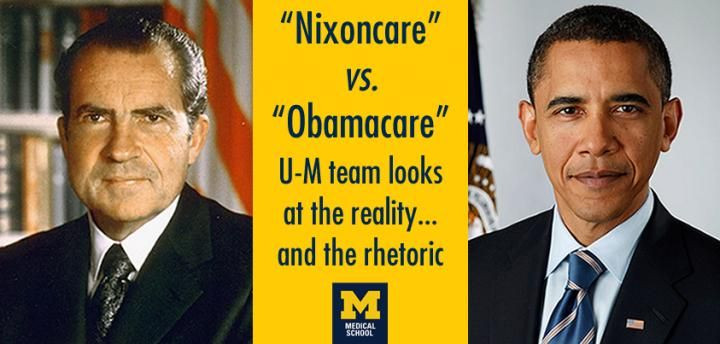A Historical Perspective On Health Care: How Does Obamacare Measure Up To Former President Richard Nixon's Health Plan

In 1971, Republican President Richard Nixon proposed arguably one of the most liberal health care plans America had ever heard of to ensure quality insurance coverage. Compared to Democratic President Barack Obama, Nixon went far beyond the reaches of a radical liberal. A new study published in the journal Pediatrics explores America’s health care policies in the context of the country’s history. Researchers dissected proposed health care acts during the Nixon administration and compared them to President Obama’s current policies in an effort to reveal how political climates shape public health outcomes.
"It's not that one is right and one is wrong," said the study’s lead author Dr. Gary Freed, a pediatrician and health policy researcher, in a press release. "But more that this is a chance to address the appropriate place of political rhetoric when it comes to improving public health, and the dangers of elevating blind partisanship over meaningful debate about important issues for our nation's health."
Freed and his research team at the Child Health Evaluation and Research Unit at the University of Michigan Medical School hope that by comparing two of the most controversial health care policies in history they'll be able to enlighten future lawmakers. After comparing the effects Nixon’s National Health Strategy would have had on today’s economy and medical system, the team concluded his approach would have covered more people than the Patient Protection Affordable Care Act (ACA, aka Obamacare) does today. Unfortunately, it never passed.
"Those who need care most often get care least,” Freed said. “And even when the poor do get service, it is often second rate... This situation will be corrected only when the poor have sufficient purchasing power to enter the medical marketplace on equal terms with those who are more affluent."
Those familiar with the historical context of U.S. health care laws, would not have been surprised when President Obama presented his administration's health care plan in 2010 because it was resoundingly similar to Nixon's. In 1972, one year after proposing the transformative plan, Nixon wrote a message to Congress on health care in which he defended his motives and elaborated on the importance of certain policies.
In it, he stated, “The general good health of our people is the foundation of our national strength, as well as being the truest wealth that individuals can possess. Nothing should impede us from doing whatever is necessary to bring the best possible health care to those who do not now have it — while improving health care quality for everyone — at the earliest possible time.”
Ultimately, the end goal is to reduce the number of people who lack health insurance coverage, and both Nixon’s plan and the ACA were designed to provide coverage to the uninsured American population while keeping health care costs down. When Nixon proposed the health care plan 44 years ago, it was considered a radical liberal approach and was met with vehement opposition from the other party. The plan was extreme compared to the ACA, but three years after it was shut down, Nixon proposed a revision with stalwart precision. However, that plan too followed suit and failed passing.
"It would be a very different country today if the Nixon plan had passed," Freed said. "Instead, we had 30 more years with one-third of the population uninsured. We need to put health care in a historical perspective, and not go to extremes for political purposes. I would hope this history will help policymakers think about what the policy is trying to accomplish for the American people, and not turn a blind eye to proposals simply because they're proposed by one party or the other."

Key Elements of Nixoncare vs. Obamacare
President Richard Nixon's National Health Strategy (1971):
- All employers are required to provide basic health insurance, including a range of specific coverage requirements.
- Employees are required to share the cost of insurance up to a cap.
- Insurance companies can only vary benefit packages to an extent.
- Special insurance programs at reasonable rates for self-employed and others.
- Replace most of Medicaid for poor families with a completely federal plan that's open to any family below a certain income level.
- Cost-sharing rises with income — those who make more share a larger portion of the financial cost.
Nixon's Comprehensive Health Insurance Plan (1974):
- All employers must insure all full-time employees with employee cost-sharing up to a cap and federal subsidies to aid employers.
- Those who can’t afford health care coverage or are not eligible for employee health insurance or Medicare, can opt for an open plan with Medicaid.
President Barack Obama's Affordable Care Act (2010):
- Business owners (with more than 50 employees) must offer affordable insurance with a minimum set of benefits to most employees, or pay extra if their employees qualify for a tax credit to buy insurance on a marketplace instead.
- Small business owners can buy insurance through a special program.
- The smallest employers can get a tax credit.
- "Affordable" coverage is defined as health insurance that costs less than 9.5 percent of household income.
- Medicaid expanded by offering states funding to cover individuals earning up to 133 percent of poverty level (fully, at first, and then weaning down to 90 percent over time).
- Provides minimum package of insurance benefits for all newly eligible individuals.
- Providers are paid equal rates for caring for Medicaid and Medicare patients.
Source: Freed G. Pediatrics. 2015.



























